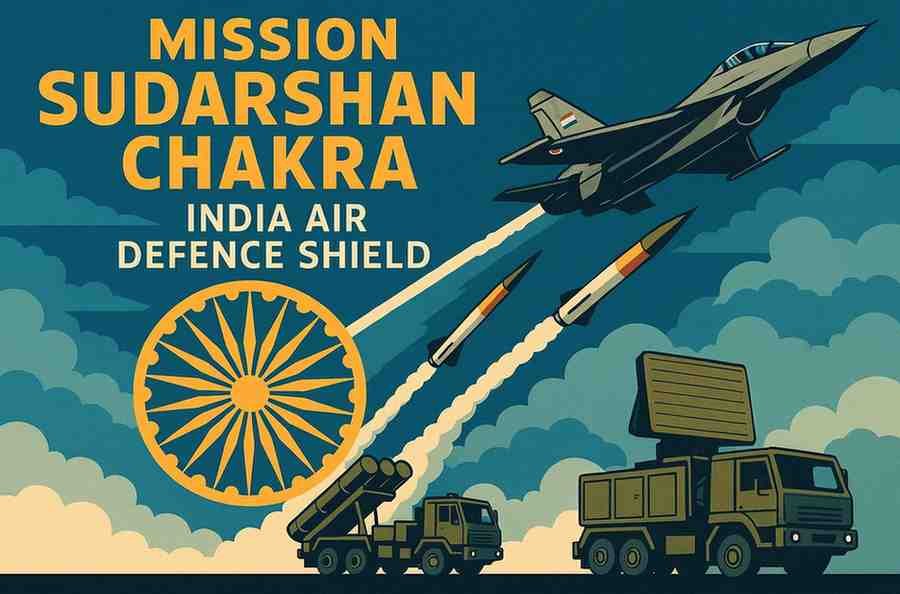Mission Sudarshan Chakra to Build India’s Defence Shield
CDS Chauhan says project demands colossal integration, multi-domain ISR
India has embarked on an ambitious journey to create one of the most advanced air defence and offence systems in the world under Mission Sudarshan Chakra, a project announced by Prime Minister Narendra Modi on Independence Day. Chief of Defence Staff (CDS) General Anil Chauhan emphasized on Tuesday that the scale of the mission will demand “a colossal amount of integration” of technologies, infrastructure, and processes to protect the nation’s strategic, civilian, and critical assets from aerial threats.
Mission Sudarshan Chakra: Shield and Sword of India
Speaking at Ran Samwad, a premier military conclave at the Army War College in Mhow, Madhya Pradesh, General Chauhan explained that the goal of Mission Sudarshan Chakra is not just defensive but also offensive. “The aim is to develop a system to protect India’s strategic, civilian, and nationally important sites. It will act both as a shield as well as a sword,” he said.
The CDS described the project as “India’s own Iron Dome or Golden Dome,” referring to Israel’s well-known missile shield. For a vast country like India, Chauhan noted, the challenge lies not only in building this defence infrastructure but in integrating it seamlessly across land, air, sea, undersea, and space domains.
Multi-Domain ISR and Sensor Integration
General Chauhan highlighted that a modern air defence grid requires multi-domain ISR (intelligence, surveillance, and reconnaissance) capabilities. This means combining inputs from multiple sensors deployed across different terrains and dimensions—land-based radars, airborne platforms, maritime systems, undersea detectors, and satellites in space.
“The picture will only become clear when multiple fields are networked. A colossal amount of data will need to be analyzed for information and real-time response,” Chauhan said. He added that advanced technologies such as artificial intelligence, machine learning, and quantum computing will be indispensable in handling the vast streams of information.
India’s Recent Breakthroughs in Air Defence
India has already made significant strides towards this integrated defence vision. On August 23, the country successfully tested a new integrated air defence weapon system (IADWS) off the coast of Odisha. The trial saw quick reaction surface-to-air missiles (QRSAM), very short-range air defence systems (VSHORADS), and a laser-based directed energy weapon destroy three different targets, including high-speed UAVs and drones, at varying altitudes.
In April, India also tested an indigenous laser weapon capable of knocking out fixed-wing drones, swarm drones, and surveillance equipment at long ranges. This positioned India among a handful of nations—such as the US, Russia, China, the UK, Germany, and Israel—that possess directed energy weapon technology.
Akashteer: Core of India’s Air Defence Grid
A key element in India’s evolving air defence architecture is the Akashteer system, which emerged as the centrepiece during Operation Sindoor earlier this year. Conducted in May, the direct military action against Pakistan followed the April 22 Pahalgam terror strike in which 26 people lost their lives.
During Operation Sindoor, Akashteer played a decisive role by ensuring real-time detection, identification, and neutralization of Pakistani missiles and drones. It was fully integrated with the Indian Air Force’s Integrated Air Command and Control System (IACCS), which serves as the backbone of India’s four-tiered air defence shield.
Between May 7 and May 10, Indian forces struck nine terror camps in Pakistan and Pakistan-occupied Kashmir (PoK), eliminated at least 100 terrorists, and targeted 13 Pakistani airbases and installations. According to Chauhan, this conflict offered critical lessons in modern warfare, most of which are already being implemented.
A Whole-of-Nation Approach
General Chauhan reiterated that Mission Sudarshan Chakra will require national-level participation, drawing expertise from defence forces, scientific institutions, private industry, and academic research. “For a project of this magnitude, India needs a whole-of-nation approach. I am sure we will achieve it at an affordable cost,” he assured.
The initiative, set to be completed within the next decade, represents one of the most ambitious steps in India’s defence modernization. By combining advanced sensors, layered missile defence, directed energy weapons, and AI-driven analytics, Mission Sudarshan Chakra is poised to become a powerful deterrent against evolving aerial threats.
Future of Warfare and India’s Vision
The Ran Samwad conclave, where these statements were made, focused on how technological advancements are reshaping warfare. General Chauhan emphasized that the integration of new-age technologies and doctrines will be the defining factor of future conflicts.
India’s Mission Sudarshan Chakra, therefore, is not just about defending against enemy strikes but about projecting strength, ensuring resilience, and establishing a credible offensive capability that will safeguard the country’s strategic interests well into the future.








